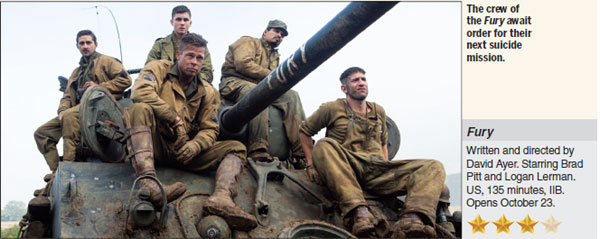A tank of a film
Updated: 2014-10-24 08:05
By Elizabeth Kerr in Hong Kong(HK Edition)
|
|||||||
David Ayer's Fury is not a meditation on the horrors of war and what it does to our humanity. It is not a deconstruction of the heroic American WWII myth of the righteous soldier protecting the world from Nazism. Questions of what makes any of us turn on a violent dime and the circumstances that inspire wretched wartime behavior are for another movie. Ayer is a pulp filmmaker, a good one, but a pulp artist nonetheless, whose preferred subject is men and how they relate to each other. Manly men doing manly things (he wrote The Fast and the Furious), charming thugs (Training Day, which won Denzel Washington an Oscar) and men making choices no one else wants to and suffering the consequences with manly stoicism (End of Watch).
Fury is a solid war drama. Nothing more. In a hybrid of Terrence Malick's esoteric The Thin Red Line and the claustrophobic action of Wolfgang Petersen's Das Boot, Sergeant Don "Wardaddy" Collier (Brad Pitt, dragging the film into prestige territory by sheer force of charisma) is tasked with leading his Sherman tank (called Fury) crew of five through the ravaged German countryside in spring 1945. Fury's first mission is to rescue a squad of soldiers pinned down in an open field, the next is to seize a small town en route to Berlin and the final is to secure a strategic crossroad to cut off a Nazi threat to the Allied supply line. Though the narrative doesn't pivot on one quest (finding Private Ryan or building a bridge) the almost picaresque structure does help ratchet up the tension - and Ayer knows a thing or two about generating tension.
Shot in gorgeously muddy tones of grey and brown that signal the film's realism, Fury doesn't have characters so much as symbols through which Ayer illuminates the masculine psyche. The film starts with Collier ambushing a soldier riding across a burnt-out terrain littered with bodies. The Nazi - he's one of many faceless villains Ayer has no time for - is riding a white horse, stark against the background, and Collier slips off his tank and stabs him without a second thought. Then he soothes the horse and sets it free. This is as deep as Ayer dives into the duality of masculinity during war. In many ways, Collier is an exemplar of the Ayer male: brutal, conflicted, squishy in the middle. The rest of the crew checks all the archetype boxes: the wet behind the ears gentle Norman (Logan Lerman, Percy Jackson: Sea of Monsters), the new driver in the army all of eight weeks; the hot-tempered loader, good ol' southern boy Grady (Jon Bernthal, The Wolf of Wall Street); the brave and crazy gunner Swan (a perfectly cast Shia LaBeouf); and Gordo (Michael Pea, American Hustle), the sensitive one.
Despite the fairly explicit anti-war message, Fury glorifies blind vengeance and ironically basks in shocking violence that elicits video game reactions from viewers. And for all the mud and blood and "realism", that mythic tone hovers over the film. We know these guys are going to die fighting the good fight. But despite its mixed messages, Fury is never less than vividly entertaining. There's a palpable stench and heat to the scenes with five men crammed together in close quarters with no plumbing. The dogfight between four American tanks and a camouflaged German "beast" is one of the year's best action sequences (Michael Bay could take a lesson in clarity from it) and the final showdown that has the crew outgunned and outmanned, bathed in a hellish orange wash, is as tense as any other regardless of the fact it has no moving parts. Fury would suffer were Pitt not around and it lumbers occasionally but for the most part it's mission accomplished.

(HK Edition 10/24/2014 page7)